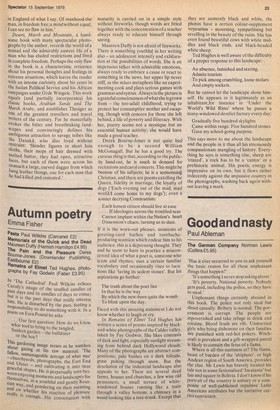Autumn poetry
Emma Fisher
Pasts Paul Wilkins (Carcanet 22) Memorials of the Quick and the Dead Maureen Duffy (Hamish Hamilton £4.95) The Pain and the Pleasure Derek Bourne-Jones (Downlander Publishing, Eastbourne 22) Remains of Elmet Ted Hughes, photographs by Fay Godwin (Faber 23.95) la 'The Cathedral' Paul Wilkins echoes Cavafy's image of the snuffed candles of Past days and lit candles of days to come; but it is the past days that really interest him. He is disturbed by the past, feeling a responsibility to do something with it. In a Poem on Ezra Pound he asks .• Our first question: How do we know what tool to bring to the tangled, Sunken garden — the bulldozer or the hoe?
This gardening image recurs as he wanders about gazing at his raw material, 'The fallow, unmanageable acreage of what was' — churchyards, photographs, the East End and Ulster — and cultivating it into neat graceful shapes. He is perpetually torn between enjoying moments and landscapes for themselves, in a youthful and gently Keatsian way, and pondering on their meaning and on whether his reaction of pleasure really is enough. His conversation with maturity is carried on in a simple style without fireworks, though words are fitted together with the concentration of a teacher always ready to educate himself through seeing.
Maureen Duffy is not afraid of fireworks. There is something youthful in her writing also — an adolescent intensity and exhilaration at the possibilities of words. She is an impetuous talker with admirable emotions, always ready to embrace a cause or react to something in the news, her upper lip never stiff, as she mixes metaphors like an experimenting cook and plays serious games with grammar and syntax. Always in the picture is a grateful consciousness of what she is grown from — the too-adult childhood, trying to protect her consumptive mother and escaping, though with concern for those she left behind, a life of poverty and illiteracy. With her, poetry seems not a mystique but an essential human activity; she would have made a good teacher.
Derek Bourne-Jones is not quite bad enough to be a second William McGonagall. But he has a good try. The curious thing is that, according to the publicity hand-out, he is much in demand for recitations and carol concerts. This might be because of his subjects; he is a sermonising Christian, and there are poems extolling the Queen, fidelity in marriage, the loyalty of dogs. Mach evening out of the mad, mad world/I come home to my dogs'); even a sonnet decrying Communism: Each honest citizen should live at ease If ideologies across the troubled seas Cannot implant within the Nation's heart Dissension's chaos, turning us to dust.
If it is the worn-out phrases, moments of greeting-card bathos and toothacheproducing scansion which endear him to his audience, this is a depressing thought. They and he seem to have in practice a misconceived idea of what a poet is, someone who scans and rhymes, uses a certain familiar vocabulary and occasionally rises to locutions like 'laving its sedent stones'. But his aspirations go further: The truth about the poet lies In that he is the way By which the new-born quits the womb To blink upon the day.
Faced with this amazing statement I do not know whether to laugh or cry. In Remains of Elmo Ted Hughes has written a series of poems inspired by blackand-white photographs of the Calder valley, taken by Fay Godwin. She likes contrasts of dark and light, especially sunlight streaming from behind dark Hollywood clouds. Many of the photographs are abstract compositions; pale bushes on a dark hillside, grass poking through snow.. But the desolation of the industrial landscape also appeals to her. There are several dead farms, houses and churches, a few wise old pensioners, a small terrace of whitewindowed houses running like a train through a valley bottom, a chimney in a wood looking like a tree-trunk. Except that they are austerely black and white, the photos have a certain colour-supplement voyeurism — mourning, sympathising but revelling in the beauty of the ruins. She has even found beautiful cows with white middles and black ends, and black-headed white sheep.
Ted Hughes is well aware of the difficulty of a proper response to this landscape: An absence, famished and staring, Admits tourists To pick among crumbling, loose molars And empty sockets.
But he cannot let the landscape alone himself. He appears in it legitimately as an inhabitant,for instance in 'Under the World's Wild Rims' where he passes a many-windowed derelict factory every day: Gradually five hundred skylights came within range. Five hundred stones Gave my school-going purpose.
This says more to me about the landscape and the people in it than all his strenuously compassionate mangling of history. Everything he sees is something else, sheep are 'crazed', a rock has to be a 'cantor' or a prehistoric animal. His poetic, energy is impressive on its own, but it flows rather indecently against the impassive country in the photographs, washing back again without leaving a mark.


































 Previous page
Previous page